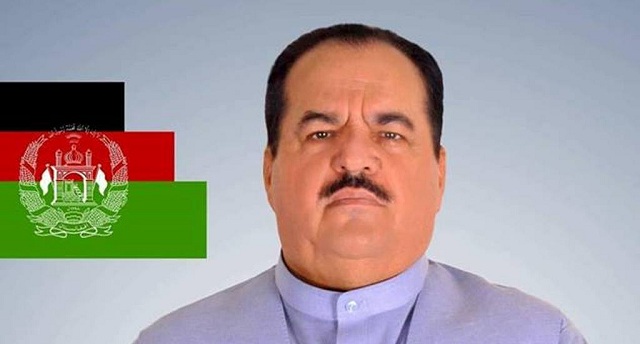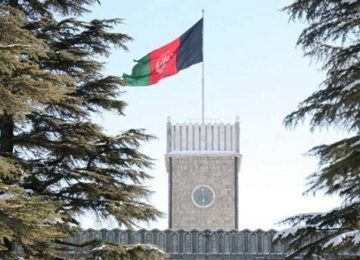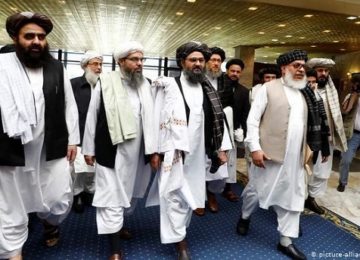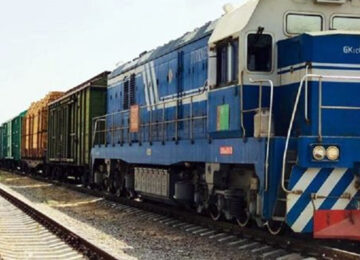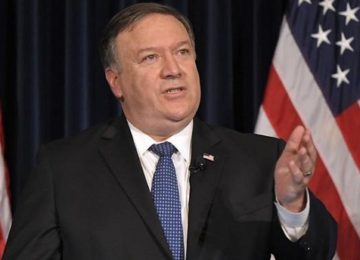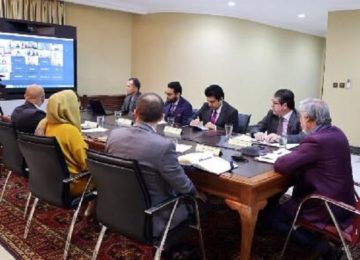The assassination of Kandahar’s police chief and strongman of southern Afghanistan Abdul Razeq in Kandahar on 18 October, along with the province’s NDS chief, and more members of the provincial leadership wounded soon overshadowed the killing of parliamentary candidate Abdul Jabbar Qahraman in neighbouring Helmand by a bomb one day earlier. Qahraman means “hero”, a title he had earned as a militia leader under former president Najibullah. His siding with the Watan Party government did not make him everybody’s hero in Afghanistan and former mujahedin declined to honour Qahraman alongside Razeq. President Ashraf Ghani paid a visit to Qahraman’s family on 28 October 2018. An obituary by guest author Michael Semple*.
Abdul Jabbar Qahraman was a larger than life figure who was directly involved in many of the momentous developments of the past forty turbulent years in Afghanistan. He died in action, in the sense that he was campaigning for the election in Helmand, when an unseen assassin detonated a bomb under his sofa. Jabbar became the tenth candidate to make the ultimate sacrifice for daring to stand for parliament.
Jabbar knew the risks. Indeed, one of the first things that he noted about the Taleban, when the movement emerged in 1994, was their decapitation strategy. He reckoned that the Taleban wanted to impose their authority by eliminating all prominent figures who did not submit to them – an echo of earlier strategies employed by the regime of the People’s Democratic Party of Afghanistan (PDPA), later Fatherland (Watan) Party (1978-92) and the mujahedin who fought it, who both eliminated or exiled the old elites. Jabbar was killed not because he was a candidate, but because he was a famous candidate and, as they highlighted in their statement, a “prominent communist commander.”
Jabbar was the son of a shopkeeper, a member of the Nurzai tribe from Spin Boldak. The family owned some land in the district but Jabbar considered them poor and reckoned that none of relatives had ever held a prominent position. The start of Jabbar’s career is an example of the Afghan military’s old meritocracy. He studied to ninth class in the Ghazi Abdullah Khan Lycee in Kandahar. Then in 1976, during the rule of republican president Muhammad Daud, the national military commission talent-spotted him and had him shifted to Kabul to join the military high school.
Jabbar was still a boy, in the military high school, when revolution came to Afghanistan. Some of his friends concluded that this was a struggle between Islam and the infidels and so Jabbar ended up dropping out and heading to Quetta, to join Hezb-e Islami. Some of his batch mates, such as Zabet Jalal, went on to become famous Hezb commanders. Jabbar spent a year and a half doing organisational work for Hezb-e Islami, before having a change of heart. “My brain began to work” is how be put it. Jabbar later claimed that he concluded that Hezb-e Islami, backed by Pakistan, could not be trusted to stand up for the Afghan national interest. He also ran into tribal problems. The main Hezb commander in Quetta, Mullah Samad, was an Achakzai. There was a long rivalry between the Nurzais and Achakzais of Spin Boldak. “I decided that I must do what was best for my country which meant going back”, is how he put it.
When Jabbar crossed back to Kandahar, he relied on friends in the Ministry of Interior and the intelligence, KhAD, to ensure a good reception. Eventually, he was given a command in Khad, sent to Tashkent for a three month training course, and then deployed to Spin Boldak. From there, Jabbar’s career took off. He recruited a group of twenty-five men and then got transferred to Maiwand, where he built up another group and was so successful that he soon found himself commanding a militia battalion of five hundred men, that was uniformed, within the MoD command structures and deployable outside its home province but still known as militia. Eventually, around 1984, the Ministry of Defence spotted him and had him transferred out of KhAD. They realised that Jabbar had the potential to mobilise men and build up militias of the sort they required to hold the line against the mujahedin. Although he retained his base in Maiwand, Jabbar ended up in command of an independent brigade group in 1988, reporting directly to the Chief of Army Staff and with forces deployed in Kandahar, Helmand, Paktia, and protecting the Kandahar-Kabul highway. He was on first name terms with President Najibullah, Defence Minister Muhammad Rafi and the key figures of both the Parcham and Khalq factions of the government.
Jabbar proudly claimed to have made it from lieutenant to major-general in six years. But he stressed that he relied on his wits and networking skills to maintain security, rather than brute force. He reckoned that, during the battle for control of Kandahar and the highway during the 1990’s, the key to his success was the hospitality he offered in his guest room. At night, Jabbar sat with people, cultivating allies in the tribes and commander networks. The achievement he was most proud of was the relief of a beleaguered garrison in Panjwai. Hundreds of government soldiers died trying to break the siege. Jabbar eventually extricated the garrison with the help of mujahedin collaborators, without a shot fired. Jabbar became famous as a militia commander, on a par with General Dostum and was given the epithet Qahraman, or hero. But he always claimed that he barely fired a shot in anger.
Jabbar was in the thick of things in April 1992, that pivotal time when the failure of Benon Sevan’s UN transition plan led inexorably to Najibullah’s lynching and the squandering of one of Afghanistan’s best chances for peace. In the run up to Najibullah’s anticipated departure, Jabbar deployed troops on the outskirts of Kabul in Deh Sabz. He claimed that he was part of the plan by the government security chiefs to secure the way for Benon Sevan to bring the transitional government from Peshawar. But Dostum and Massud pre-empted the plan, taking over Mazar-e Sharif and then deploying troops to Kabul airport. This was a time when everyone had to pick a new side. Jabbar talked directly with Hekmatyar and threw in his lot with Hezb-e Islami again. Jabbar helped bring Hezb forces into the capital, to counter the northern militias. The stage was set for an Afghan civil war.
Jabbar’s 1992 alliance with Hekmatyar did not last long and he withdrew his men to Helmand. In one of the forgotten episodes of the conflict, Jabbar teamed up with fellow militia commanders Khano and Allah Nur – nominally linked to Jamiat-e Islami – to maintain security in central Helmand. For over a year after the collapse of the Najibullah government, the militias maintained the status quo in Lashkargah, Gereshk, Nad Ali and Nawa. They nominally affiliated with new president Rabbani, but focused on protecting Helmand from the chaos of feuding mujahedin commanders, as witnessed in neighbouring Kandahar and the capital. Eventually Jabbar concluded that their secular enclave was unsustainable. He persuaded General Dostum to organise a nocturnal aerial evacuation to northern Afghanistan, for the Helmand militia leaders. This marked what Jabbar considered the beginning of his “life of wandering”. He divided his time between stints in Quetta under the protection of veteran nationalist politician Mahmood Khan Achakzai, Mazar under protection of Dostum and Moscow, where he started an export-import business. Jabbar offered advice but was never again a major conflict actor.
After the collapse of the Taleban government, Jabbar returned to Afghanistan. His first initiative was a tuition centre in Lashkargah. As if trying to recreate the spirit of the Helmand republic of 1992-1993, the centre boasted a tranquil flower garden, and classes in advanced mathematics, computing, language and science.
But in spirit, Jabbar was still an inveterate political networker, who believed that the links he had cultivated during his time as a militia commander could help end the war. He was elected to the 2010 parliament, which sometimes looked like a reintegration programme for the commanders who faced each other across the frontlines in the 80’s and 90’s. Jabbar’s confidence, intelligence and occasional bombast guaranteed that he would get noticed in parliament. President Ghani was persuaded by Jabbar to appoint him as special representative for security in Helmand. The experience was both frustrating and educative, regarding the difference between Afghanistan of the 1990’s and Afghanistan after 2001. Jabbar found the administration in Helmand more factionalised and resistant to efforts at coordination than when, in the late 1980s, he and General Nur-ul-Haq Ulumi – then in similar role for southern Afghanistan for the PDPA/Watan regime as General Razeq until recently – had contended with Khalq-Parcham rivalries, while trying to co-opt the mujahedin and stabilise Kandahar. Even with the President’s backing, Jabbar could not stamp his authority on the different bits of the security apparatus in contemporary Helmand, and he stepped down from his position in Helmand. However, undaunted, he re-launched the defunct and officially banned Hezb-e Watan in July 2017 (AAN background here) and, when the 2018 parliamentary poll was called, was determined to stand for re-election.
Killing off famous Afghans like Jabbar Qahraman is one of the most sinister aspects of the current Taleban campaign. The assassinations hint at a broader authoritarian project of social control, which involves stripping society of its cultural and historical focal points. The Taleban keep their top leaders cloistered and often obscure the identity of their field commanders and officials. Scholars have documented the ambiguity of the relationship between the Taleban, the tribes and Afghan culture. The Taleban have their roots in the tribes and have repeatedly instrumentalised tribal networks. But the movement has also suppressed traditional tribal authority. The Taleban movement cultivates an image of anonymity and potency.
Jabbar the Hero in 2018 was not a military threat. Rather, Jabbar was someone everyone knew and who could mobilise Afghans through appeals to tribal bonds, or an heroic past or an envisioned future. He was an obstacle to the Taleban’s imposition of the hegemony of their anonymous cadres. He will not be the last Afghan to be killed for being famous. But there are many more Afghans who share his core optimism that the country will survive and emerge from this painful conflict.
By Special Arrangement with AAN. Original link.
Disclaimer: Views expressed on this blog are not necessarily endorsed or supported by the Center for Research and Security Studies, Islamabad.



